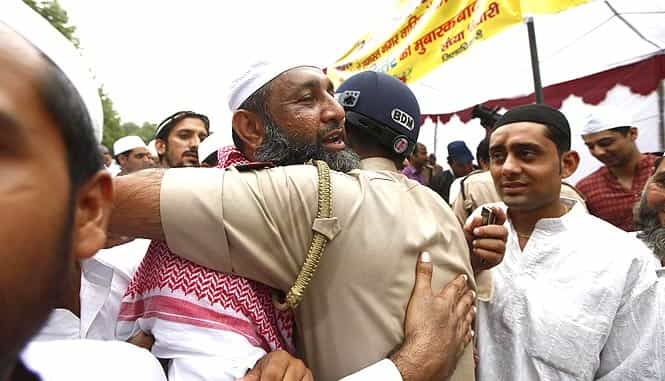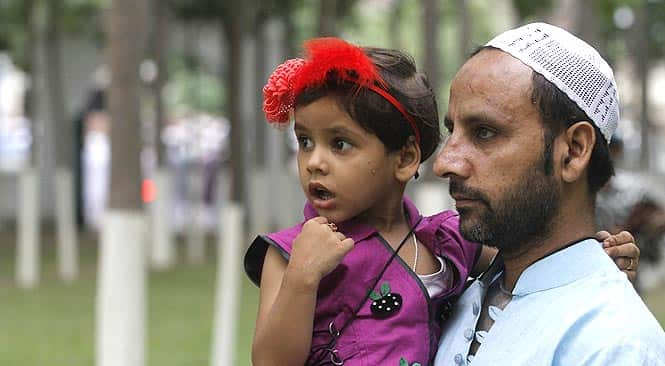This too shall not pass: Saharanpur riots may go unpunished
The best way to judge an administration’s abilities is not by how quickly they impose curfew and control the situation but how well they prevent such incidents, writes KumKum Dasgupta. Saharanpur: Curfew relaxed for 2 hours, Muslims offer Eid prayers
Last night, as I roamed around the Old City of Delhi after a satisfying pre-Eid meal, I met a friend of mine who has just come back from riot-hit Saharanpur in Uttar Pradesh.
“The atmosphere is so different there [Saharanpur]... it’s so very tense,” he said as we tucked into Shahi Tukra, a bread pudding with dry fruits, flavoured with cardamom, a specialty of the Jama Masjid area.
The neighbourhood was in a festive mood: people were gorging on fruits, kebabs, kachoris and other delicacies and wrapping up their last-minute Eid shopping. As we stood there outside Mehboob Perfumery, one of the best known ittar shops of the area, and soaked in the celebratory mood, we were told that the curfew would be relaxed in parts of Saharanpur from 7am-11am and 3pm-7pm on Tuesday. But there is a catch: people will not be allowed to gather in large numbers to congregate at the Saharanpur Idgah because of the prevailing tension.
Read:

A Muslim man hugs a police official during the Eid ul-Fitr festival, marking the end of Ramzan in Saharanpur. (Virendra Singh Gosain/HT Photo)
I have not been to Saharanpur but from what I gather from news reports and friends on assignment there, the riots were waiting to happen - and that there could be more such conflagrations in the coming months in UP.
While I hope these cynics are proved wrong, the state administration really needs to work on its administrative skills if it wants to ensure peace. It is now clear that even after Muzzaffarnagar and Moradabad, the message that the government will not tolerate violence and punish the guilty has not gone through.
While there was no overt manifestation of any dispute between the Sikhs and the Muslims in Saharanpur over the piece of land, there was underlying tension for months in the area and in the absence of mediation effort by the administration, the situation spiralled out of hand.
Though much has been said about how the district administration’s quickly controlled the violence, I think the best way to judge an administration’s abilities is not by how quickly they impose curfew and control the situation but how well they pre-empt such incidents. And on this count, the Saharanpur administration has failed miserably.
In an article on riots, psychoanalyst Sudhir Kakkar, author of The Colours of Violence, writes: “Efforts to punish the rioters after the episode are not as effective as prevention. This is mainly due to the difficulties in identifying individual rioters and the high political costs of punishment if the rioters are associated (as they often are) with powerful political parties or the regime. The failure to punish, in further reducing the risk, will then only foster the recurrence of rioting”.
The state and the district administration should have been on their toes because post-Muzzffarnagar and the general elections, the polarisation between communities have been complete.

Muslims celebrating after prayer during the Eid ul-Fitr festival, marking the end of Ramzan in Saharanpur. (Virendra Singh Gosain/HT Photo)
“The result of the general election has made the Muslim vote irrelevant. Then there were incidents like Muzzaffarnagar, Moradabad and Pune where a young Muslim boy was killed without provocation.... all these incidents coalesced to create unhappiness, tension...,” a Jawaharlal Nehru University professor told me while discussing Saharanpur.
“Then there are the manipulative leaders on both sides. In fact, Muslims have been ill served by leaders like Azam Khan and Imran Masood.”
While we blame - rightly so - local administrations for not being able to stop communal violence, the role of politicians, especially in ‘smaller’ riots, often go unscrutinised because of lack of evidence and their political clout. This is dangerous because conflagrations of this size (Saharanpur) keeps the pot boiling and have the ability to stoke fire somewhere else in the country.
Look at what happened in Saharanpur: with by-elections in October, Congress leader Imran Masood and BJP MP from the constituency, Raghav Lakhanpal Sharma, blamed each other for the riots and polarising the electorate and accused each other of instigating their communities. Masood also accused the Samajwadi Party, which has named Sanjay Garg as its candidate, for instigating people.
After the Muzzffarnagar riots, the UP government began probing the role of politicians in the sectarian violence and was duly criticised. While the BJP condemned such a probe, the Congress demanded a white paper in the assembly on the issue.
A year on, nothing has come out of that probe and no political party is even asking for it. May be the parties have finally realised that people who live in glass houses shouldn’t throw stones.
(Contact the author on Twitter: @kumkumdasgupta)





